Works by Shazia Sikander in the Asia Society Triennial. (Photo by Ben Davis.)
The Asia Society Triennial Has a Lot of the Same Problems Most Biennials Do. But It Also Crystallizes a New Trend in Art
"We Do Not Dream Alone" gives a glimpse of "delegated handicraft" as a biennial style.
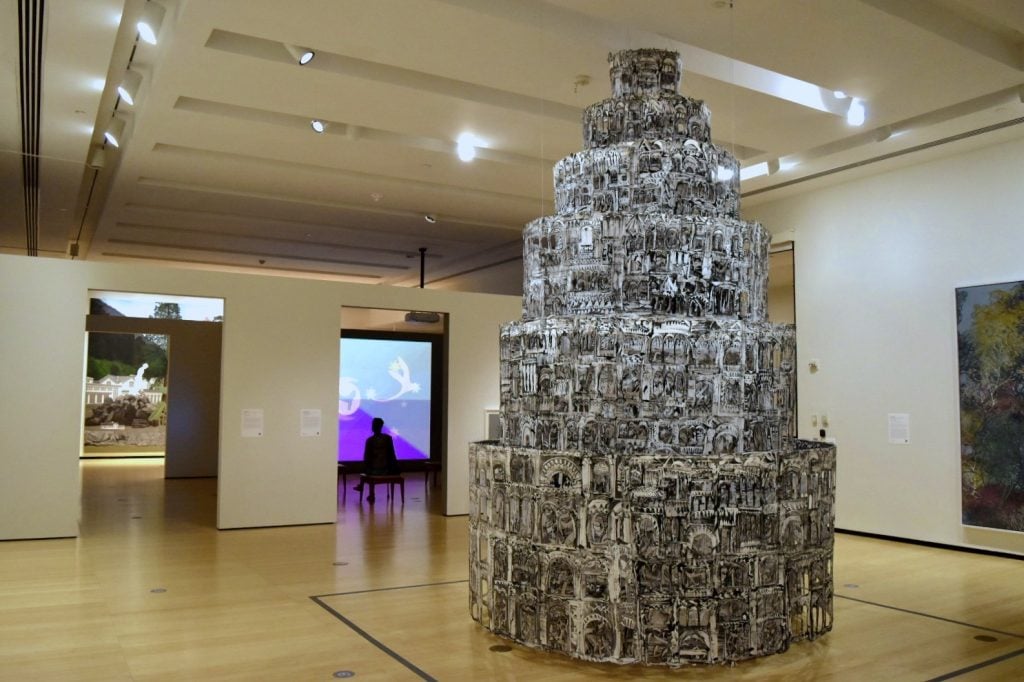
“To say there was not some heartache would not be true,” co-curator Michelle Yun told the New York Times. (A part 2 will open in February, conditions permitting.)
Yet, all things being equal, a less-punishing scale and an end to pointless gigantism are actually positive developments when it comes to the universe of international biennials. The central part of the show at the Asia Society’s HQ on Madison Avenue gives you a manageable selection of works by twenty-some artists, spaced out over two floors. (There’s an auxiliary section installed at the New York Historical Society, which I’m not getting into.) Yet in rolling back the tide of ambition, the event also ends up flushing to the surface some of the dilemmas of this style of show as well.

The Asia Society. (Photo by Ben Davis.)
Take a work like that by Xu Bing, commissioned by the Asia Society for the Triennial. Xu is an already famous Chinese artist, and a good one. Here, he’s been asked to respond via art to the US Declaration of Independence, a reproduction of which is hung on the wall, for a show-within-a-show called “We the People” (it also features Sun Xun’s folding album depicting Donald Trump as an evil dragon).
Xu presents a copy of Confucius’s Analects, inspired by the fact, previously unknown to me, that the Founding Fathers were interested in classical Chinese philosophy. Displayed beneath a plexiglass box, the book has been coated in a fine cobweb of silk, via a process that involves letting live silkworms extrude on them, documented in a nearby film.

Xu Bing, Silkworm Book: The Analects of Confucius (2019). (Photo by Ben Davis.)
The silk-covered book is an interesting object. The idea behind the gesture, I think, is to point to a deep, wholesome cosmopolitanism, as if asking people who fetishize “American” identity by appealing to mythical Founding Fathers, in a time of anti-Chinese xenophobia, to think again—a fine idea, albeit one unlikely to move anyone who doesn’t already agree.
As a whole installation, though, the parts don’t really connect. Silkworm Book ends up reducing to the contemporary-art formula: “interesting object + piece of trivia + text explaining connection.” This has been a general problem with new commissions made in our (temporarily slowed) production-for-production’s sake biennial circuit, with its bottomless hunger for made-to-order meaning.
As a whole installation, though, the parts don’t really connect. Silkworm Book ends up reducing to the contemporary-art formula: “interesting object + piece of trivia + text explaining connection.” This has been a general problem with new commissions made in our (temporarily slowed) production-for-production’s sake biennial circuit, with its bottomless hunger for made-to-order meaning.
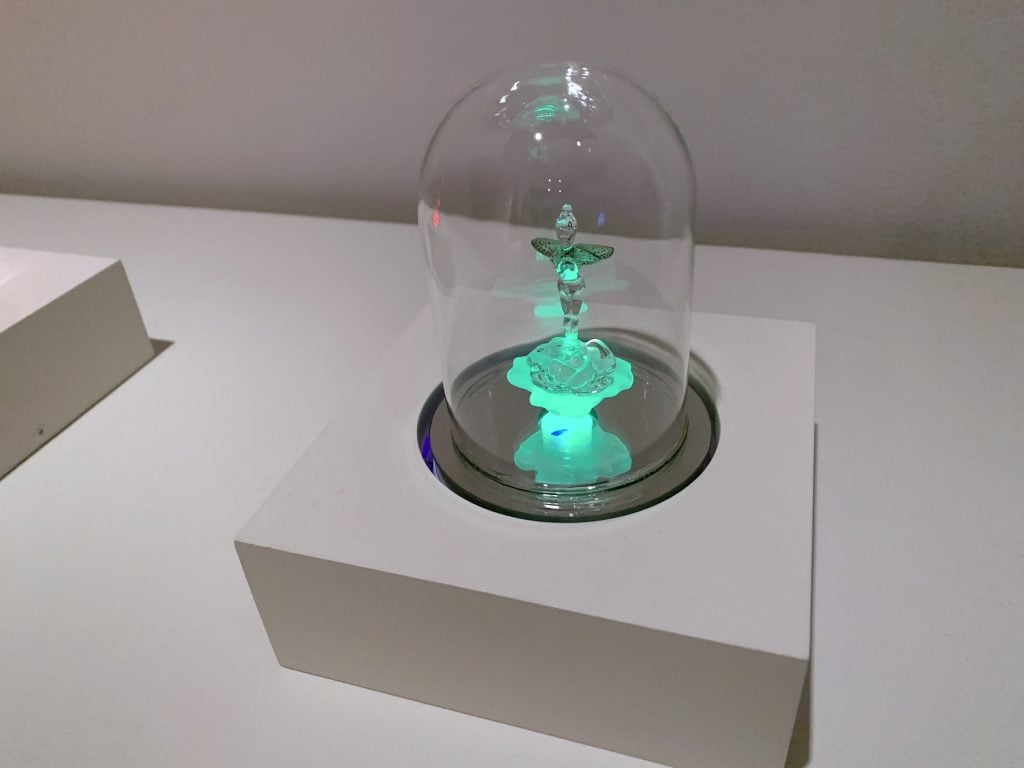
Detail of Ken and Julia Yonetani, Three Wishes (2014) in the Asia Society Triennial. (Photo by Ben Davis.)
Overall, this first Asia Society Triennial spotlights an immense geographic area in its handful of figures, from Israel to Japan, passing through countries that represent the bulk of the world population in between. Yet despite this staggering breadth of different geographies and national cultures, artistically, the overall tone here is set by a music box version of It’s a Small World emanating from Japanese duo Ken and Julia Yonetani’s small installation featuring little glass Tinkerbells in jars, affixed with real butterfly wings, which a text explains is a commentary on Walt Disney’s role in promoting nuclear power.
Which is to say that this is a biennial that looks like it is full of biennial art. Its themes feel broadly representative of those acculturated to what is effectively its own cosmopolitan, educated, and mobile global subculture. These tropes include globalization itself as subject matter; a distanced but not aggressive irony towards traditional practices and beliefs; and respectful, semi-conceptual work documenting marginalized groups and political trauma.
For my taste, the artwork that pops out here is a corner full of ink paintings by Nandalal Bose (1882-1966). Born literally a century before some of the other figures here, he hails from a totally other configuration of culture than today’s hyper-connected one. In his home country, Bose is an artist of immense stature. He was in charge of illuminating India’s first, hand-written Constitution in 1950.
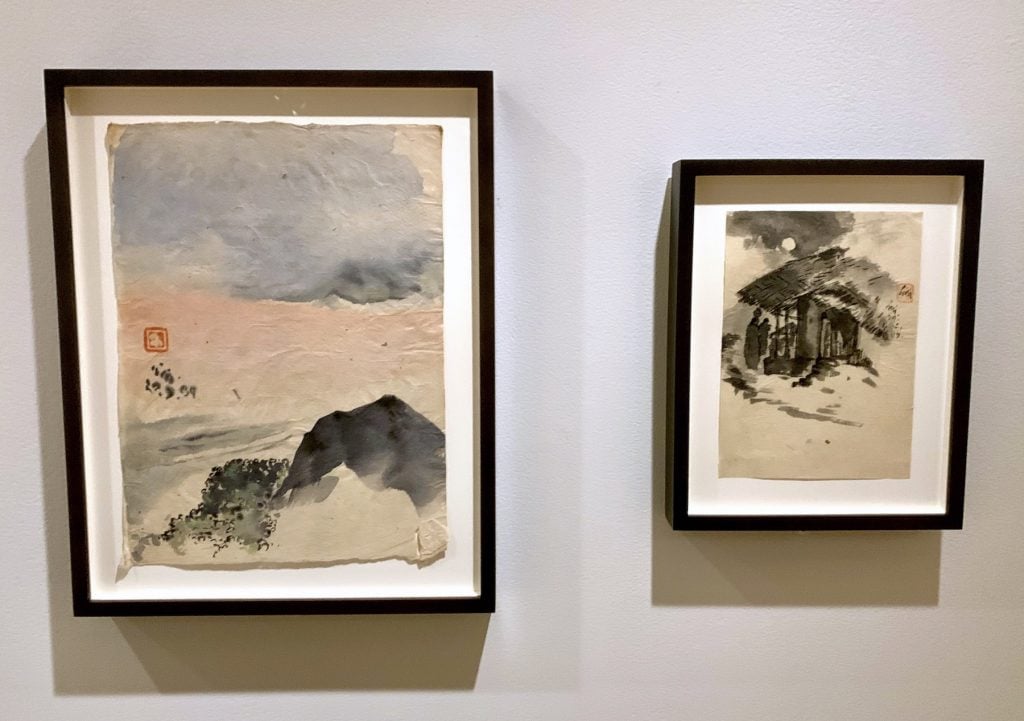
Untitled works by Nandalal Bose in the Asia Society Triennial. (Photo by Ben Davis.)
Bose’s modest corner gives only a whisper of a sense of his status as having helped define India’s modern artistic identity. But the small suite of airy ink wash images of flowers and Indian landscapes explicitly show the way his art was shaped by his encounter with East Asian artistic traditions. They sent me home to discover Inaga Shigemi’s article on Bose’s relation with Japanese artists, which argues that his ink works are “an appeal for a Pan-Asian challenge to the overwhelming domination of Western modernism.” Connecting to that story is worth the price of admission as far as I’m concerned.
For myself, aside from the Bose and Shahzia Sikander’s delightful The Scroll—a storybook-like work, made when she was a student in Lahore, that evidently launched the well-known artist’s career back in the ’90s—what most interested me here was how this Triennial helped throw into focus a larger contemporary-art trend.
No less than three works at the Asia Society involve delegated craft production, where the fact that the object in front of you is the product of a commission by the artist from anonymous artisans, working across borders, is symbolically important.
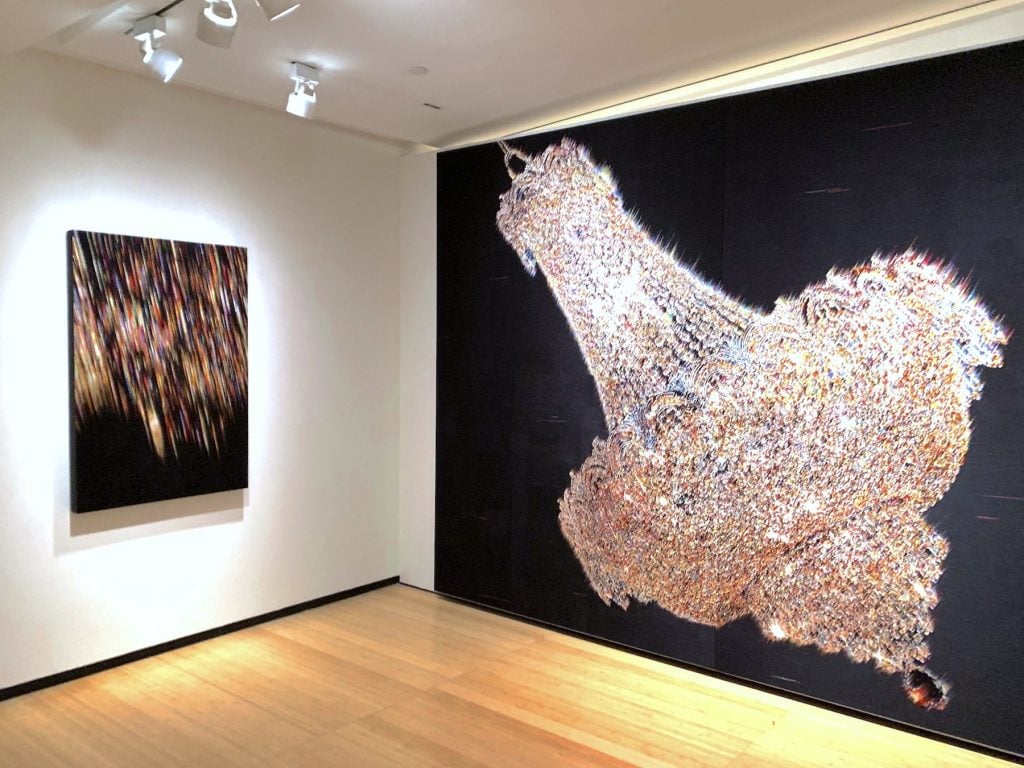
Works from Kyungah Ham’s “What You See Is the Unseen / Chandeliers for Five Cities DSK 04-D-05” series (2016-17) in the Asia Society Triennial. (Photo by Ben Davis.)
Seoul-based Kyungah Ham’s series of embroidered panels feature renderings of luxuriantly glimmering chandeliers at different levels of abstraction, and are the work of unknown North Korean artisans—”an attempt,” the text says, “to connect the common people whose lives continue to be dictated by the partition of the Korean peninsula.”
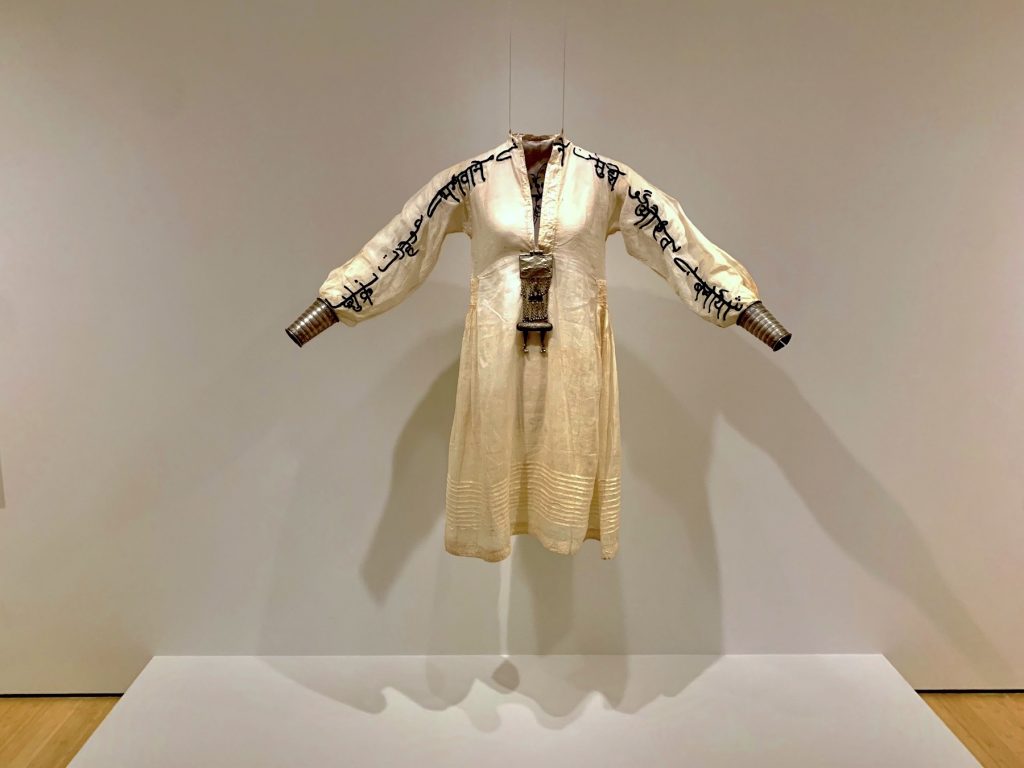
Ghiora Aharoni, Thank God for Making Me a Woman, III (2019) in the Asia Society Triennial. (Photo by Ben Davis.)
Israel-born, New York-based Ghiora Aharoni makes traditional Indian garments stitched with ironic religious slogans in self-invented languages (“Thank God for Making Me a Women,” reversing the line “Thank God for Not Making Me a Woman” from Orthodox Jewish prayer). They have been crafted by male artisans of Muslim faith in India, in a somewhat confusing commentary on patriarchy.
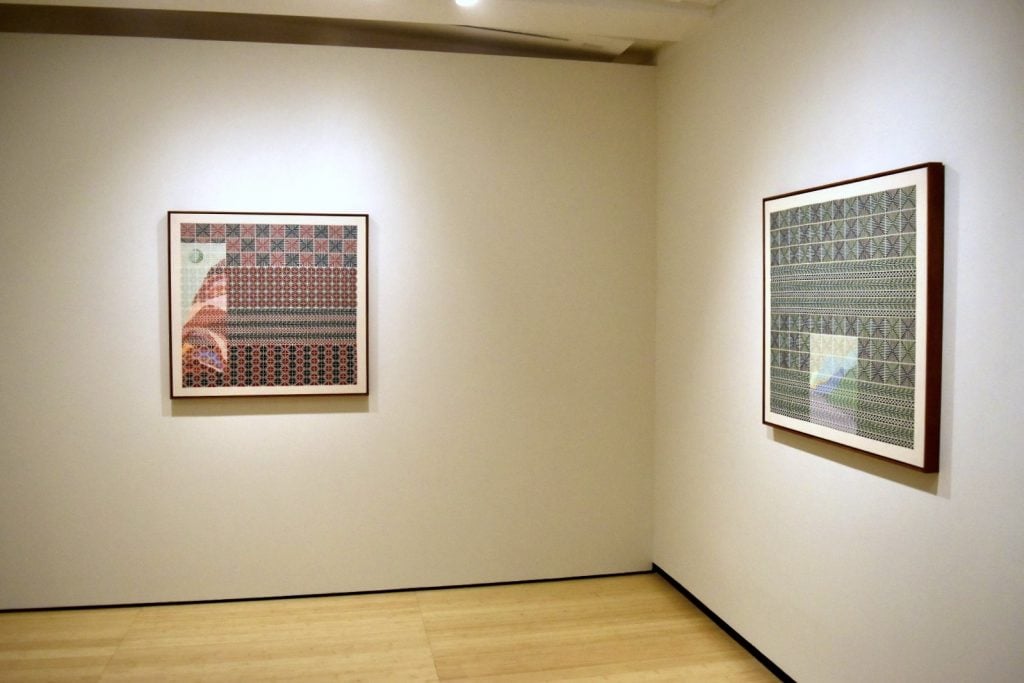
Jordan Nassar, I Am Waiting for You (2018) and Memories (2018). (Photo by Ben Davis.)
And New York-based Jordan Nassar, whose family background is Palestinian, has embroidered cotton-on-cotton panels made in traditional patterns by women artisans in the West Bank, then elaborates these so that they appear to have enigmatic image fragments poking into their grid (a show highlight).
These are very different projects, with a common trope. They neither fit the type of the recent “return to craft,” nor are they cynical conceptual commentaries on the unequal power balance of center to periphery. What symbolic work does “delegated handicraft” do that brings it to the surface here?
First, it opens a back door to the very real tactile aesthetic pleasures of craft and traditional arts.
Second, handicraft signals towards senses of place and tradition absent from global commercial art, with its focus on individual expression and signature product lines.
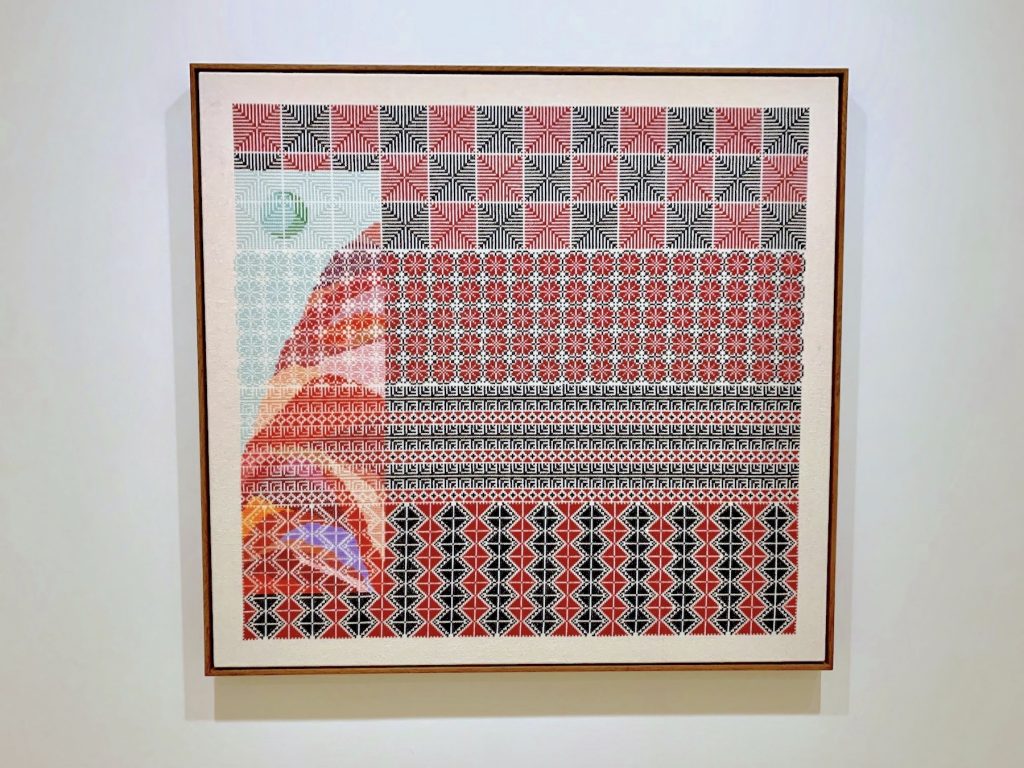
Jordan Nassar, I Am Waiting for You (2018) in the Asia Society Triennial. (Photo by Ben Davis.)
Third, by making an explicit theme of its own manufacture, it gives the in-gallery art object a sense of bigger political and conceptual consequence. The viewer isn’t just looking at something but witnessing the end point of a social process.
Fourth, this kind of work thematizes the potentials of cultural exchange—the ur-topic of global biennial culture rooted in hyper-mobile creators. The artist actually plays a split role, as manager setting the terms of the project, and as ambassador, reminding the audience of the cultural specificity of the labor being put to work.
In that sense, “delegated handicraft” reflects the pressures on an event like the Asia Society Triennial itself. On the one hand it advertises a sense of opening up new cultural vistas; on the other it offers something that fits right into the global landscape.
More images of the Asia Society Triennial, below:
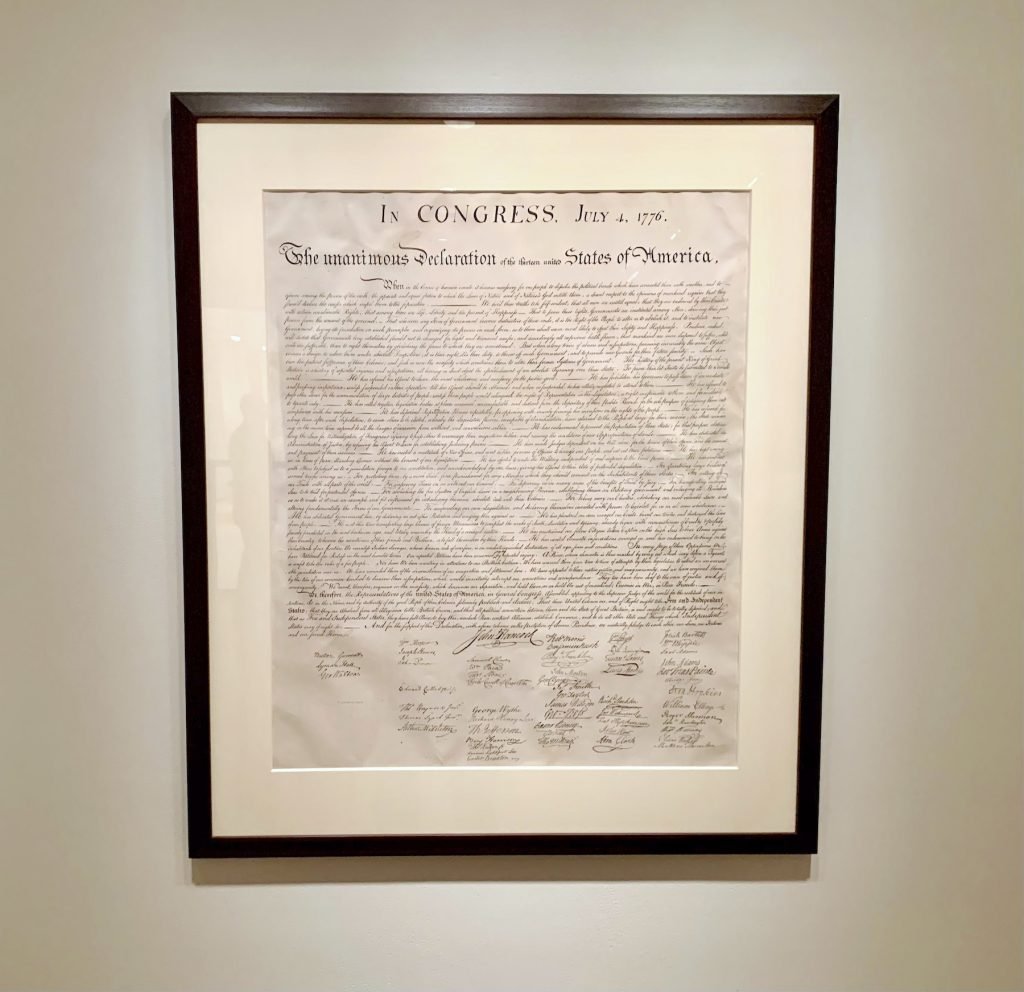
A copperplate engraving of the Declaration of Independence, as part of “We The People: Sun Xun and Xu Bing Respond to the Declaration of Independence” in the Asia Society Triennial. (Photo by Ben Davis.)

Sun Xun, July Coming Soon (2019) in the Asia Society Triennial. (Photo by Ben Davis.)
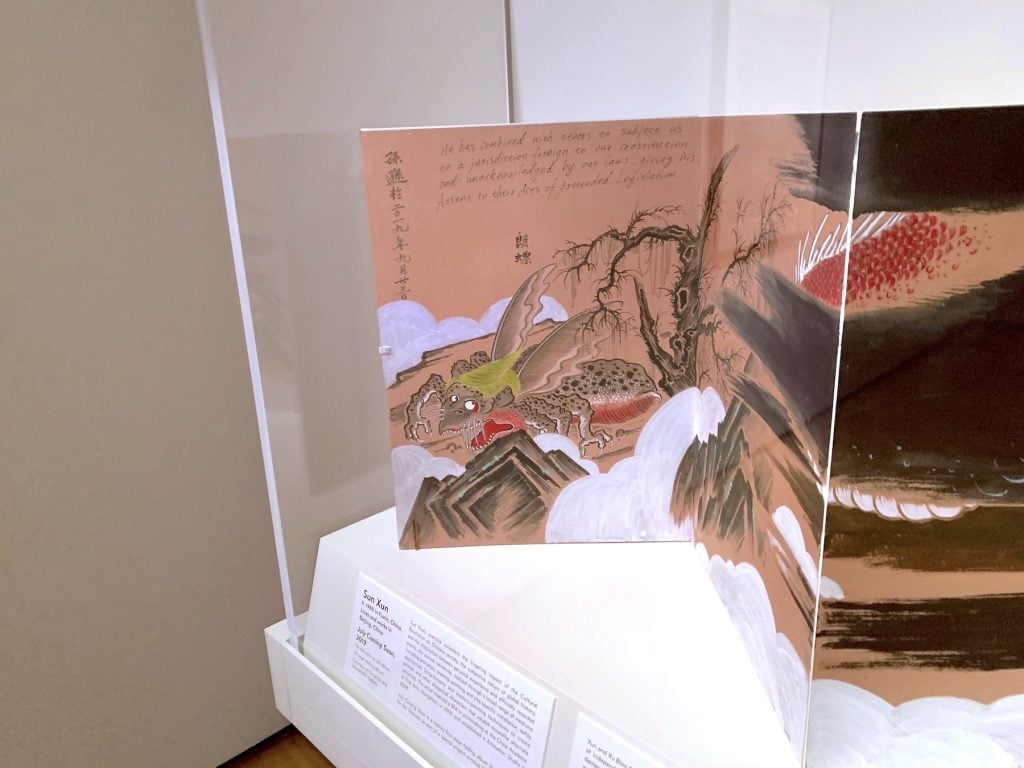
Sun Xun, July Coming Soon (2019) in the Asia Society Triennial. (Photo by Ben Davis.)
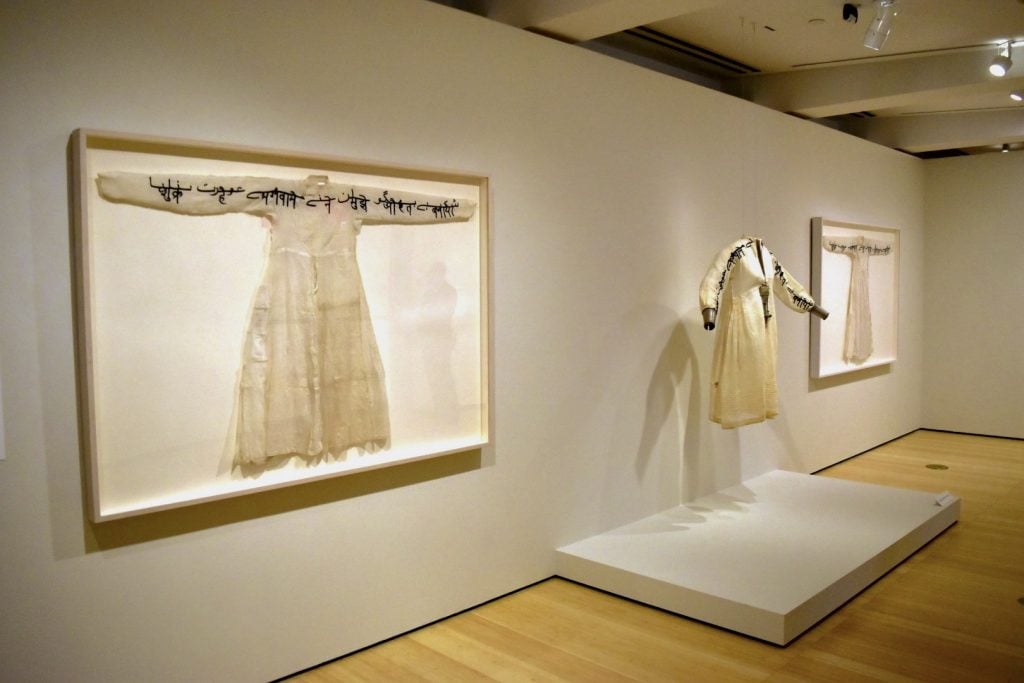
Works from Ghiora Aharoni’s “Thank God for Making Me a Woman” series in the Asia Society Triennial. (Photo by Ben Davis.)
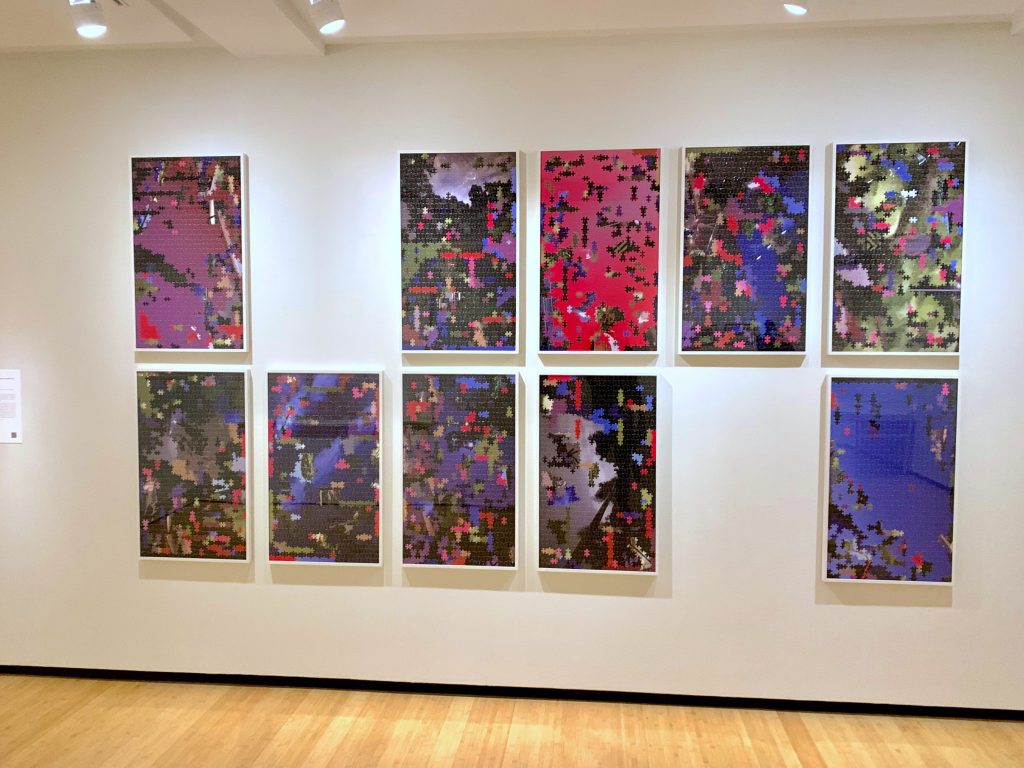
Jason Wee, Uncommon Choreographies (2020) in the Asia Society Triennial. (Photo by Ben Davis.)
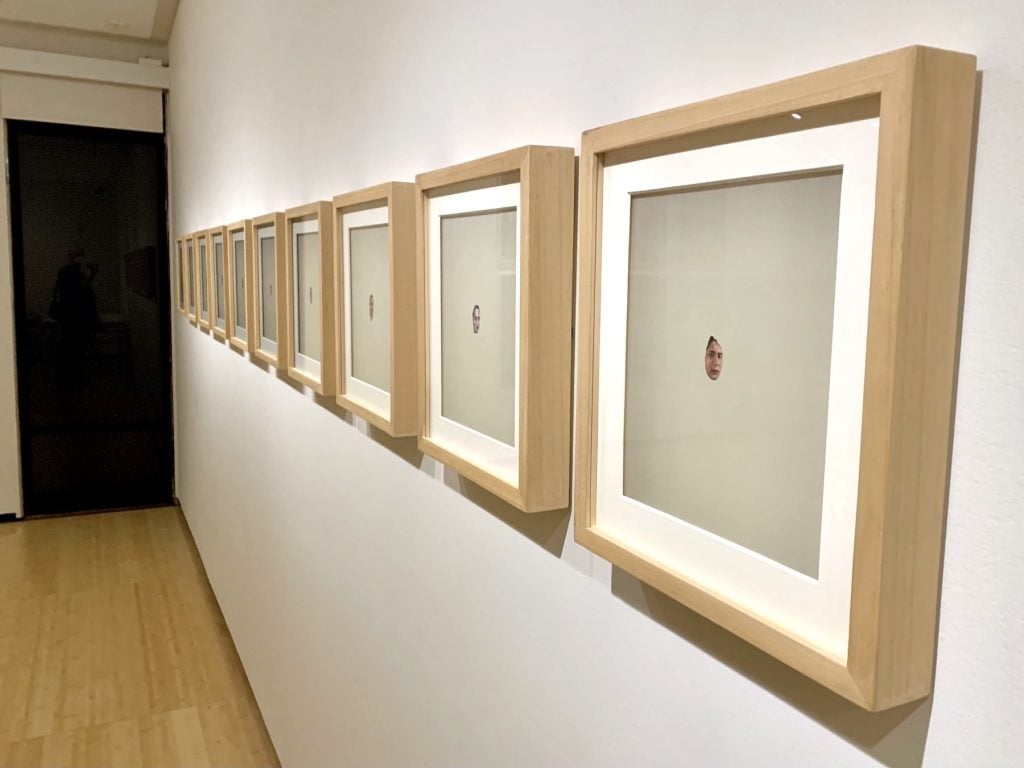
Hamra Abbas, Every Color (2020) in the Asia Society Triennial. (Photo by Ben Davis.)
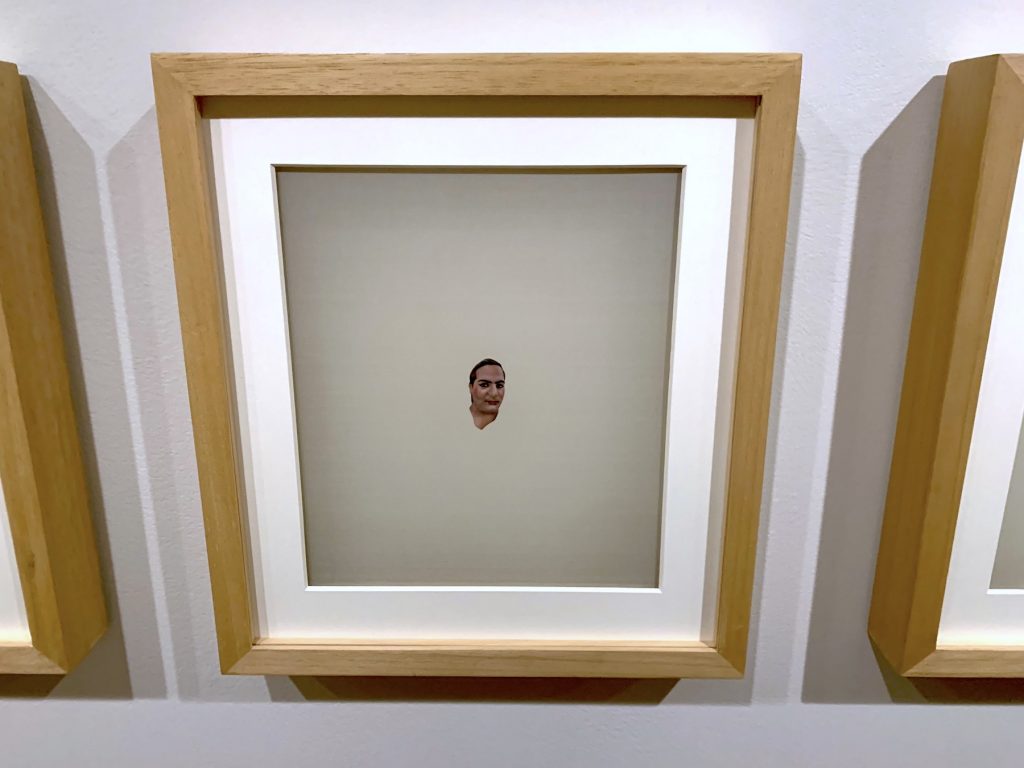
Hamra Abbas, Every Color (2020) in the Asia Society Triennial. (Photo by Ben Davis.)
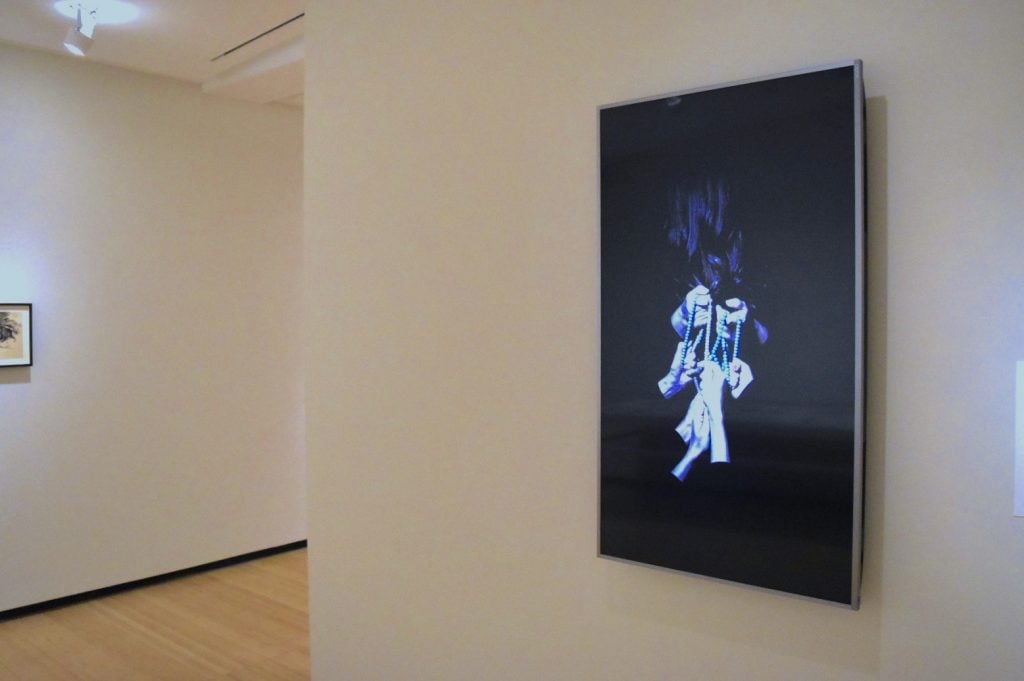
Nasim Nasr, 33 Beads (Unworried) #1 (2018) in the Asia Society Triennial. (Photo by Ben Davis.)
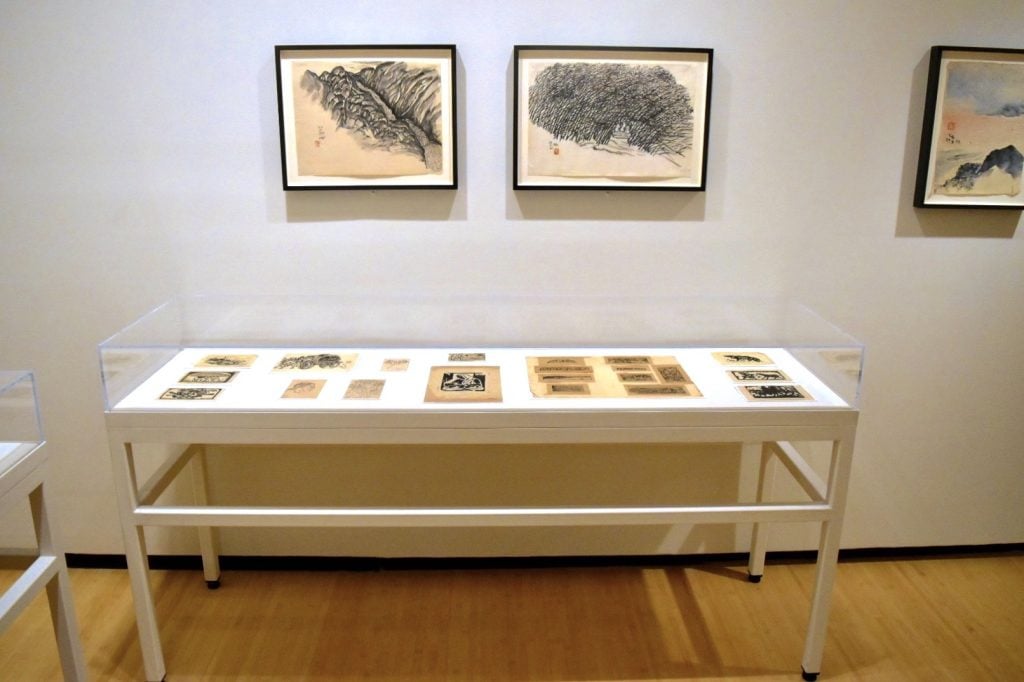
Works by Nandalal Bose in the Asia Society Triennial. (Photo by Ben Davis.)
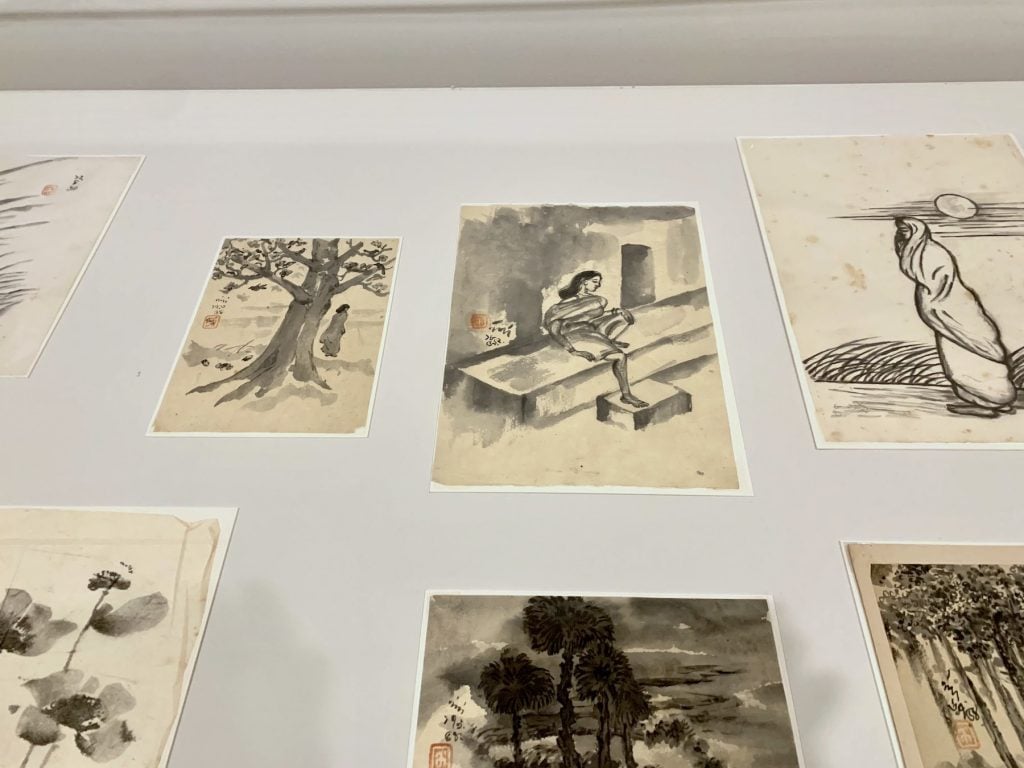
Detail of Ken and Julia Yonetani, Three Wishes (2014) in the Asia Society Triennial. (Photo by Ben Davis.)

Anne Samat, Follow Your Heart Wholeheartedly (2020) in the Asia Society Triennial. (Photo by Ben Davis.)
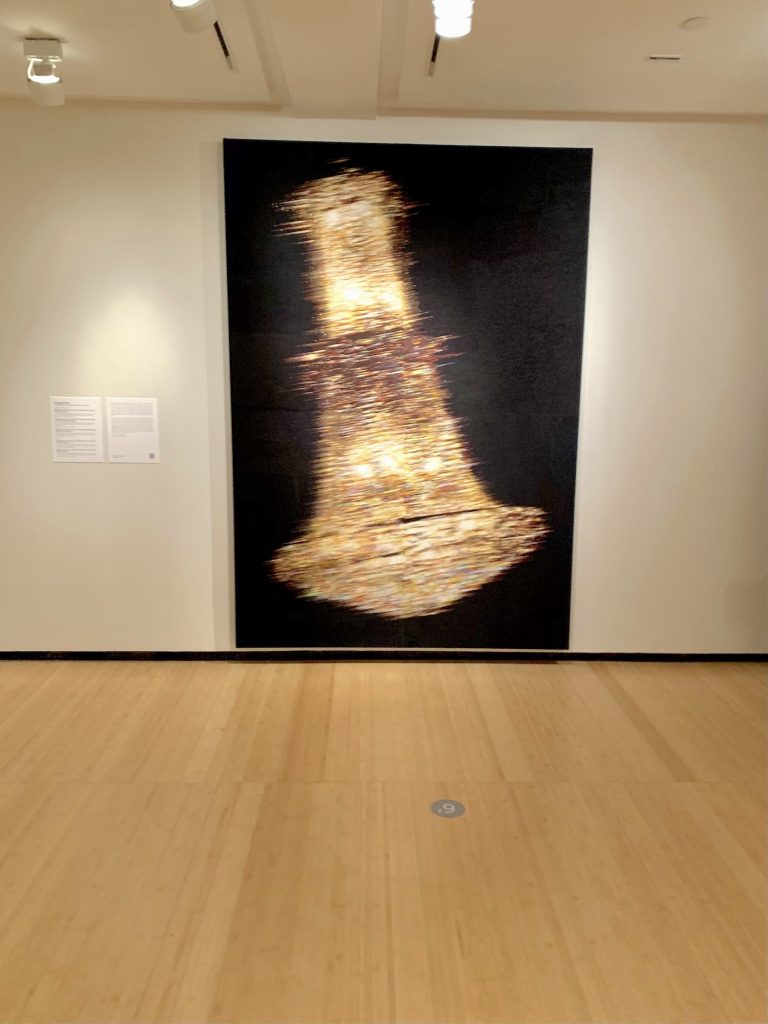
Work from Kyungah Ham’s “What you see is the unseen / Chandeliers for Five Cities” series. (Photo by Ben Davis.)
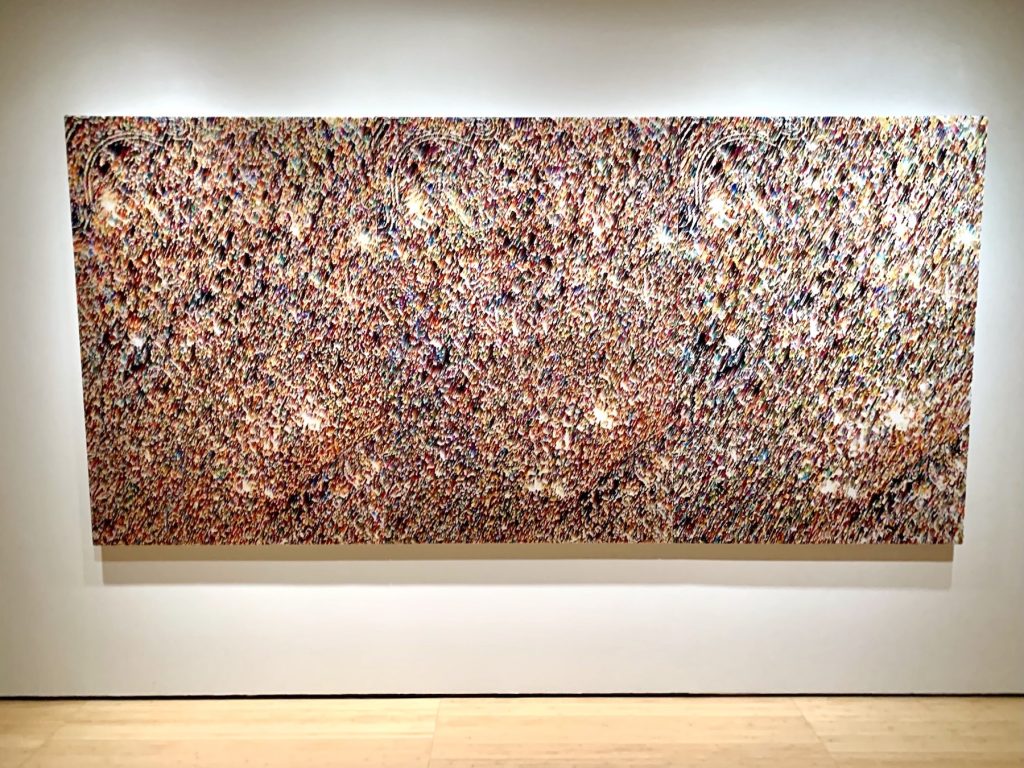
Work from Kyungah Ham’s “What you see is the unseen / Chandeliers for Five Cities” series. (Photo by Ben Davis.)
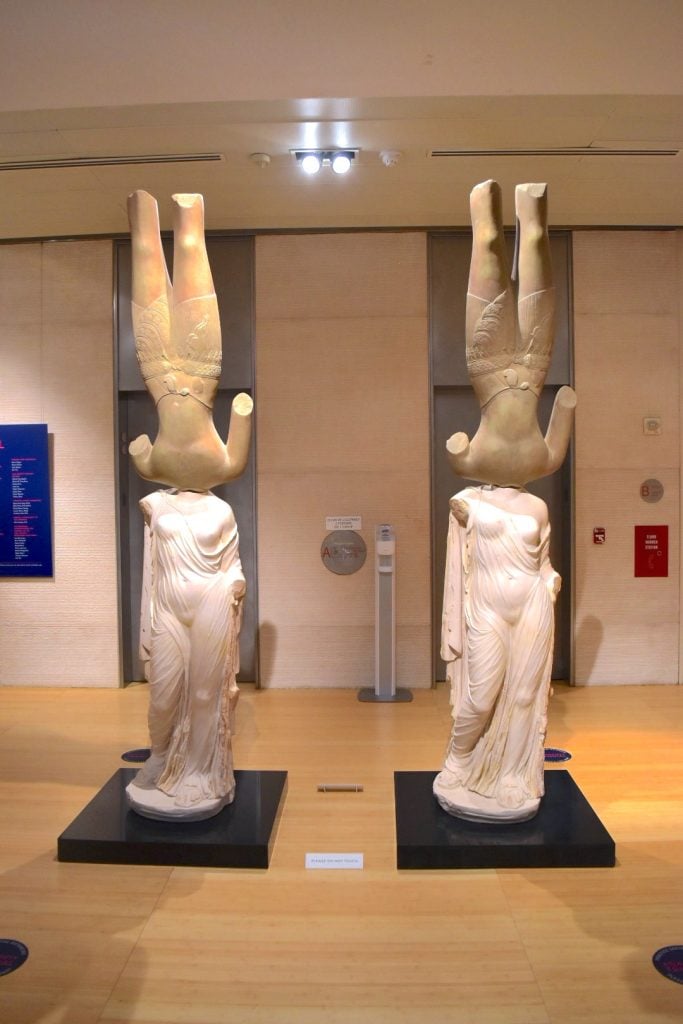
Xu Zhen® , Eternity—Male Figure, Statue of Venus Genetrix (2019-20) in the Asia Society Triennial. (Photo by Ben Davis.)
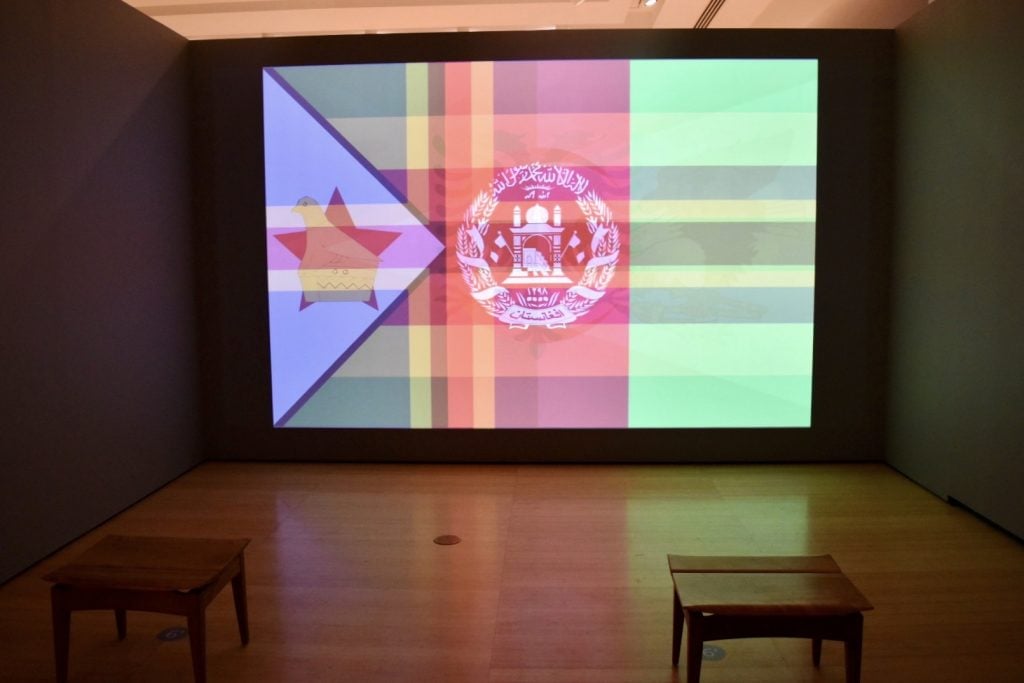
Kimsooja, To Breathe—The Flags (2020) in the Asia Society Triennial. (Photo by Ben Davis.)
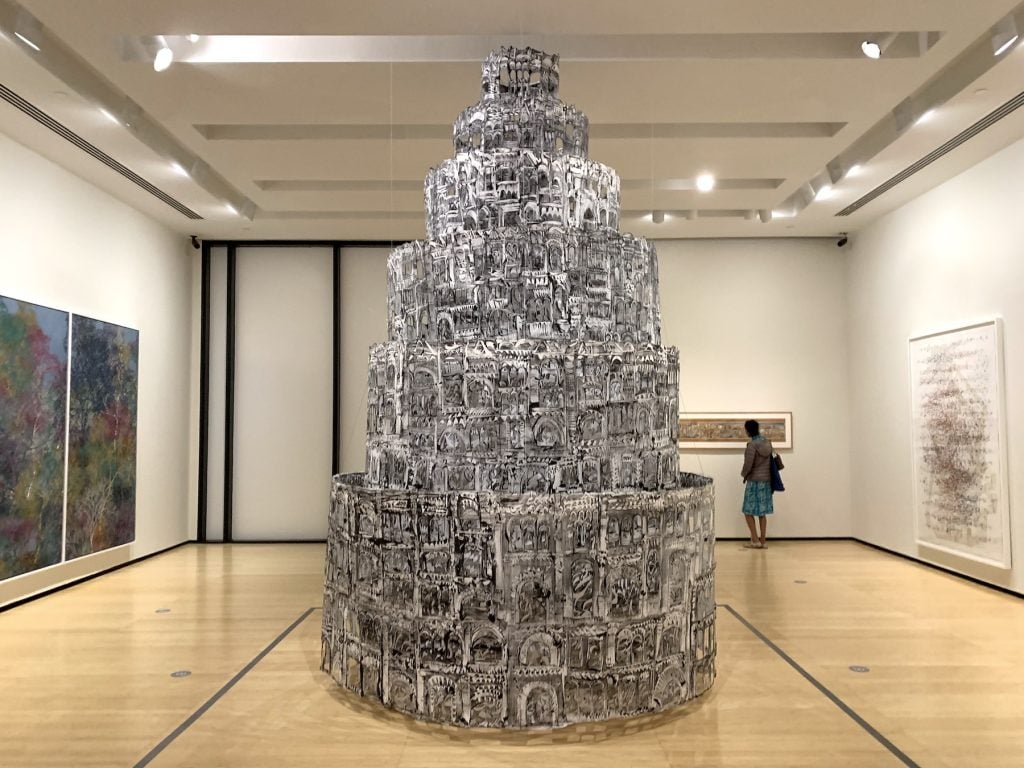
Installation view of work by Kevork Mourad, Seeing Through Babel (2019) in the Asia Society Triennial. (Photo by Ben Davis.)
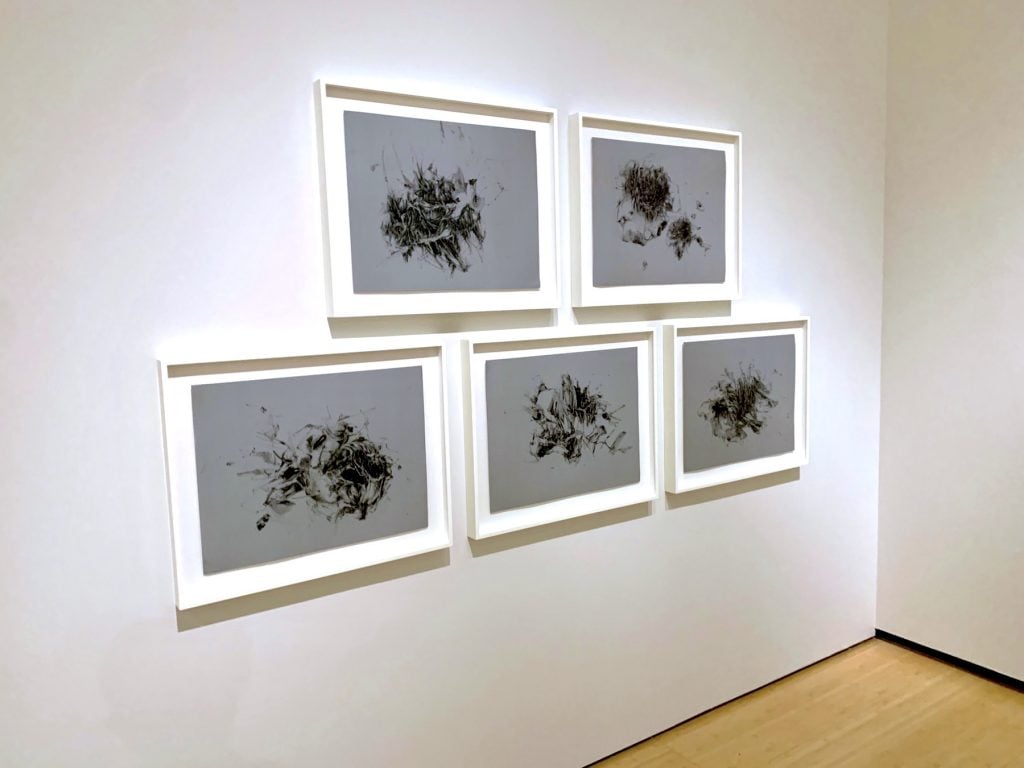
Works from Christine Ay Tjoe’s “Floating in the Near Distance” series (all 2018). (Photo by Ben Davis.)
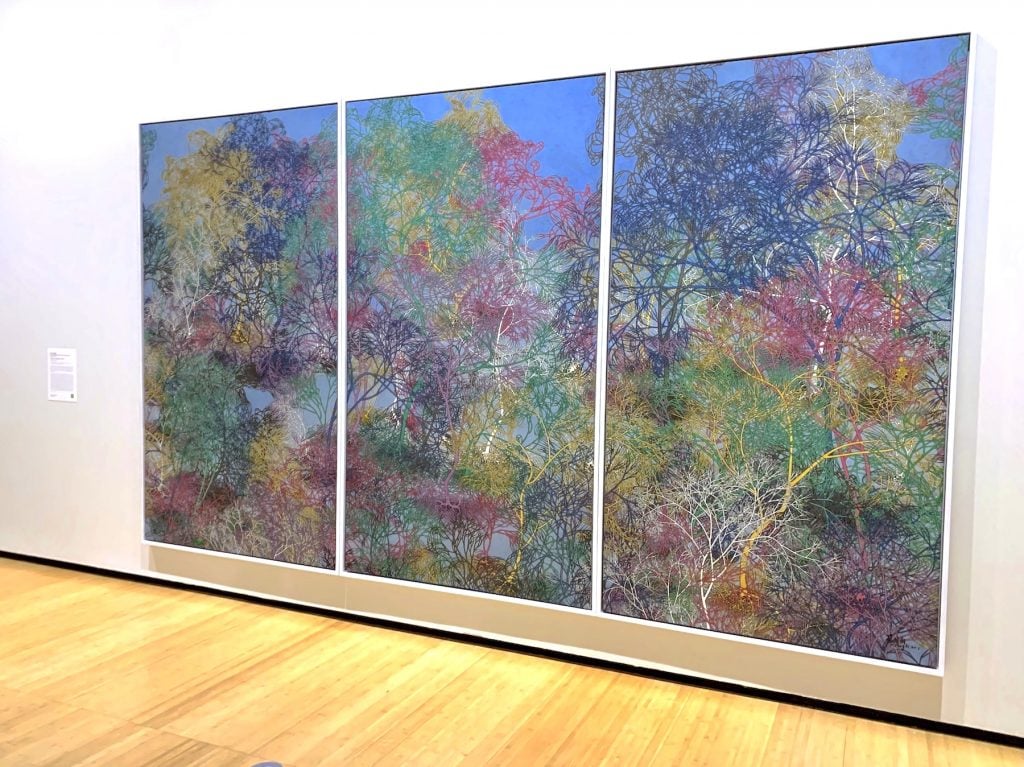
Lao Tongli, The Desire of Libido No. 5 (2017-19) in the Asia Society Triennial. (Photo by Ben Davis.)
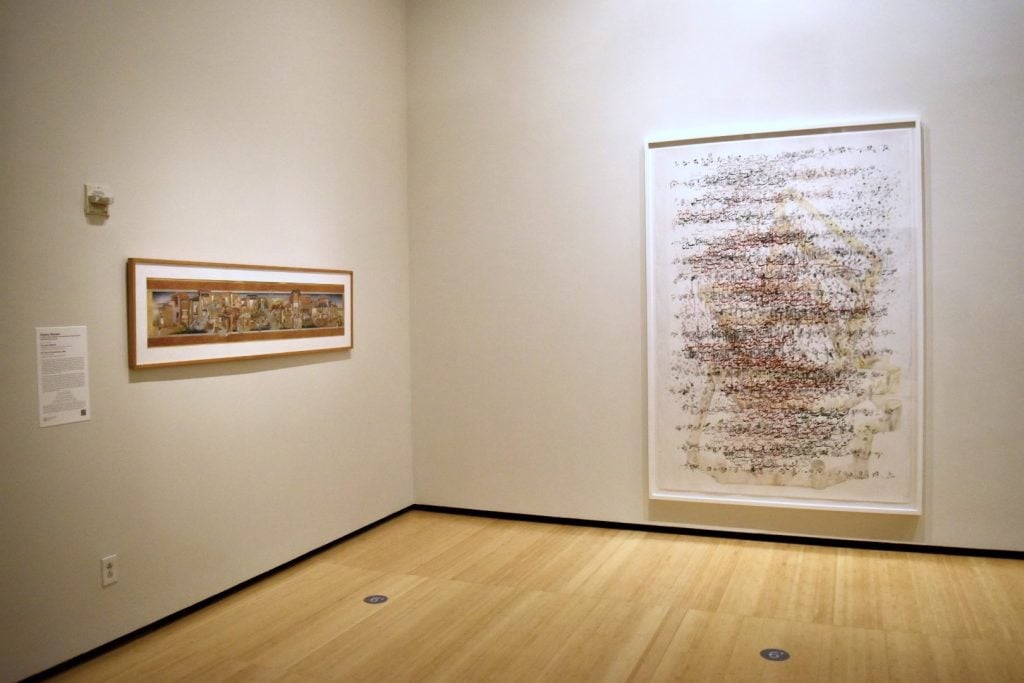
Works by Shazia Sikander in the Asia Society Triennial. (Photo by Ben Davis.)
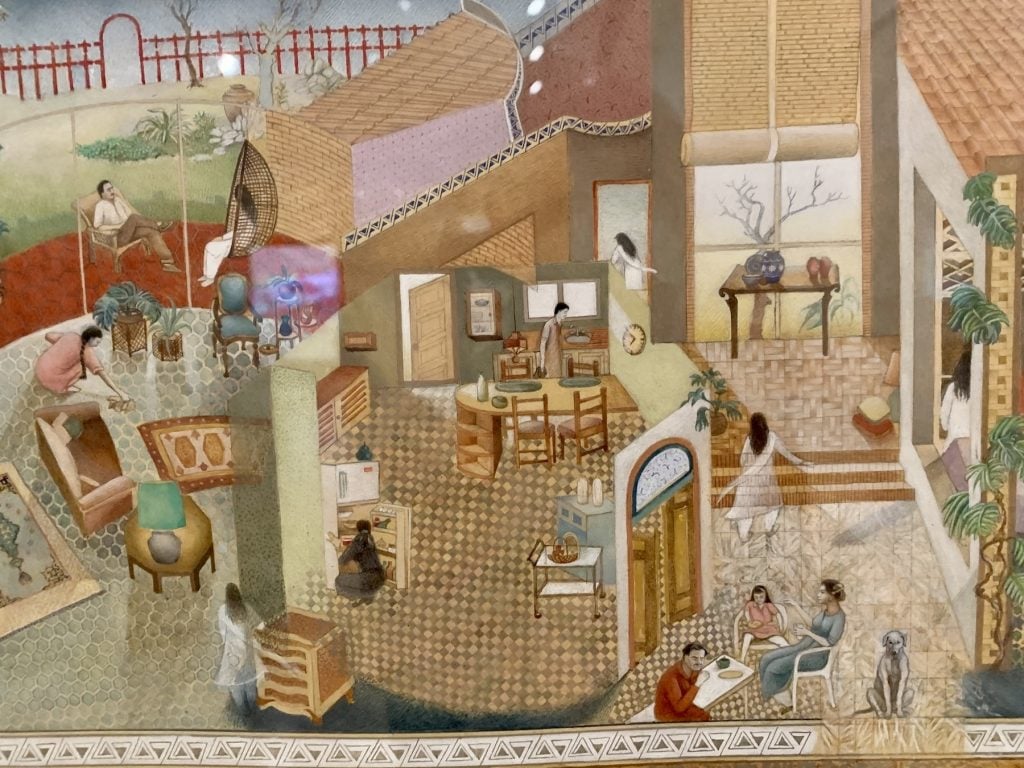
Detail of Shahzia Sikander, The Scroll. (Photo by Ben Davis.)
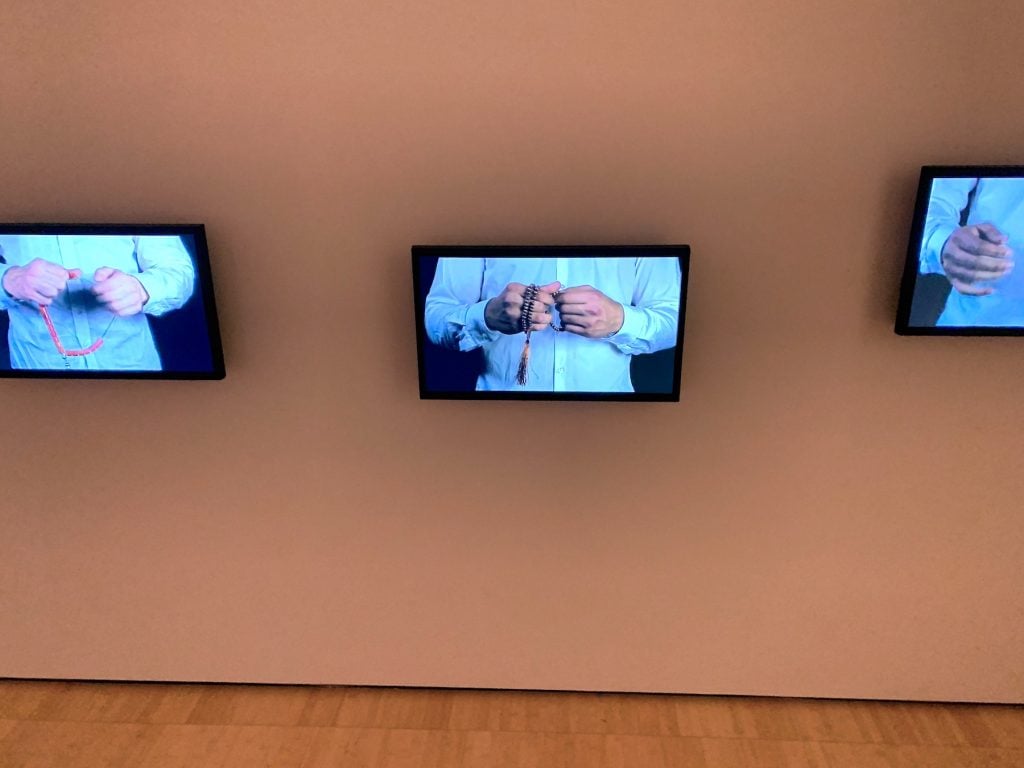
Nasim Nasr, What to Do? in the Asia Society Triennial. (Photo by Ben Davis.)
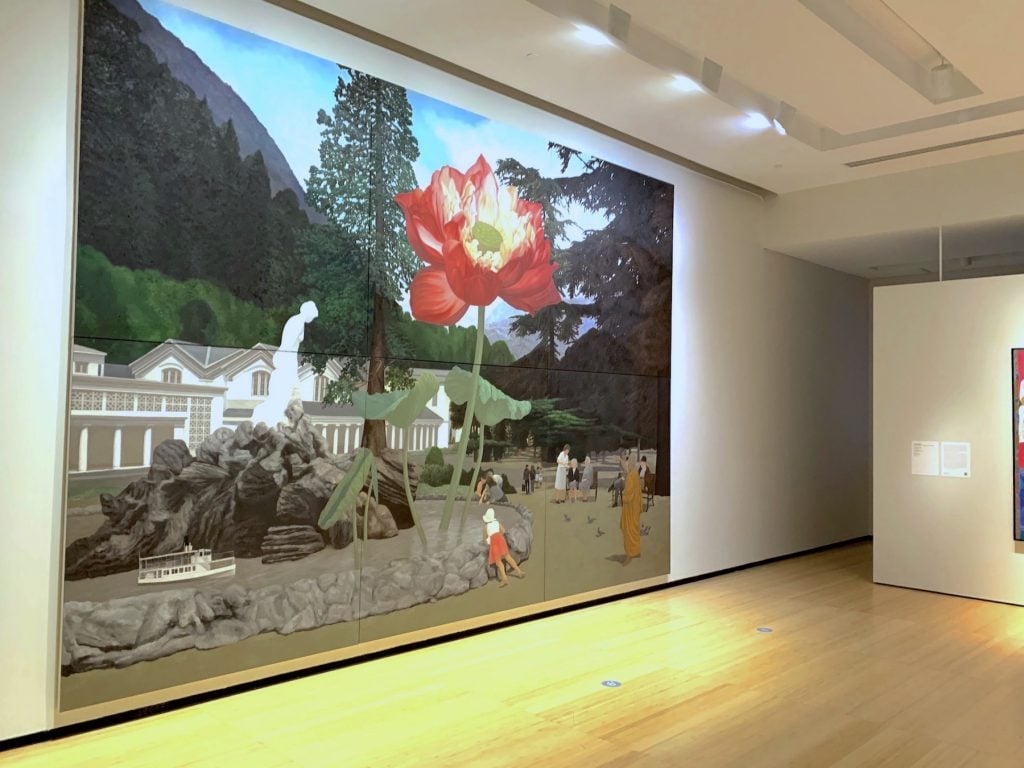
Natee Utarit, The Dream of Siamese Monks (2020) in the Asia Society Triennial. (Photo by Ben Davis.)
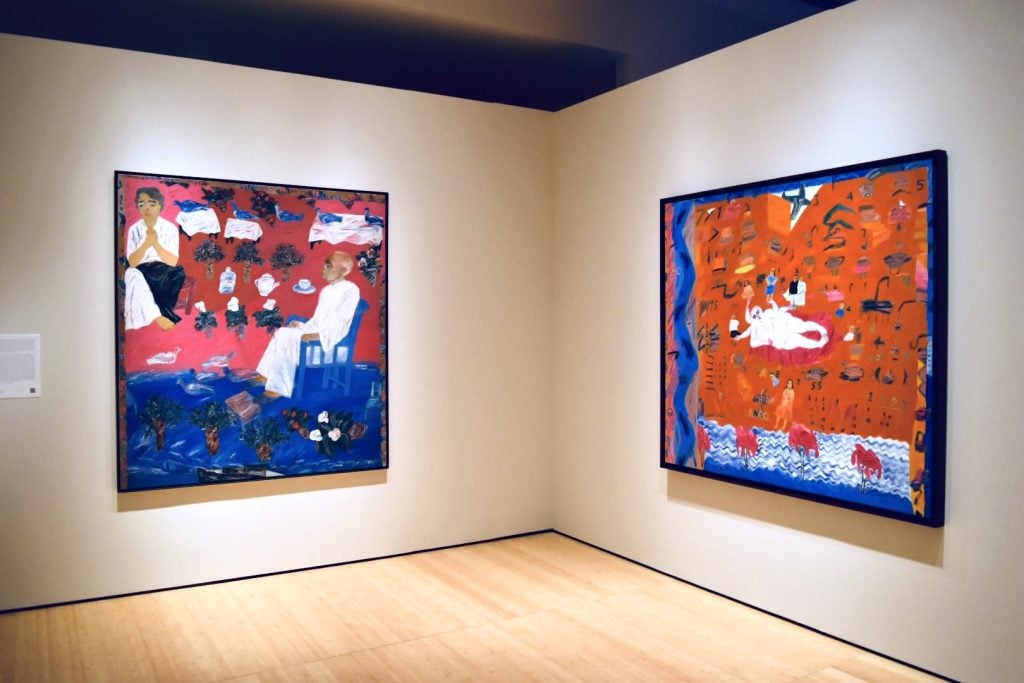
Works by Arpita Singh in the Asia Society Triennial. (Photo by Ben Davis.)
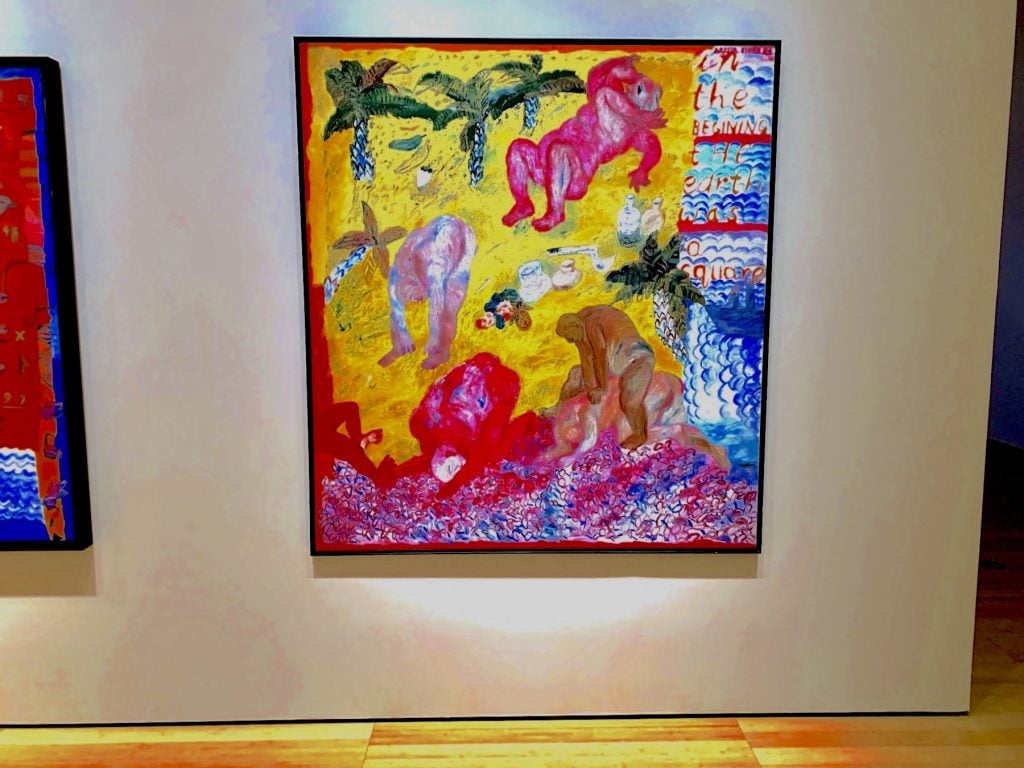
Arpita Singh, The Ritual (1989) in the Asia Society Triennial. (Photo by Ben Davis.)
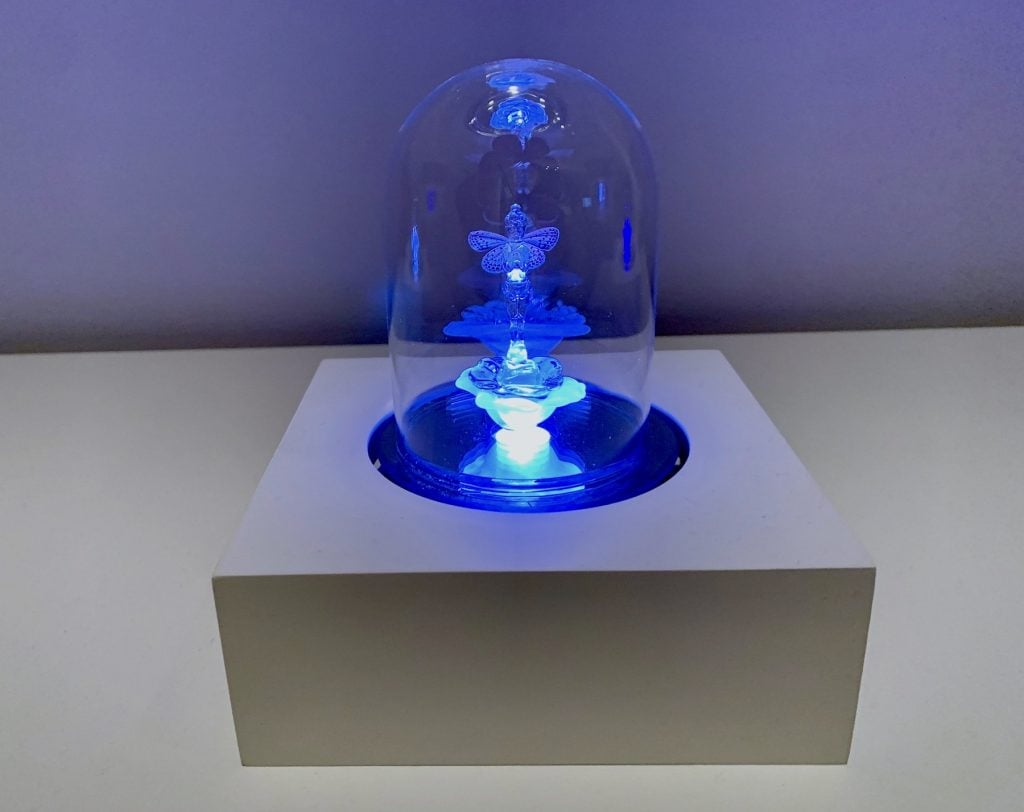
Detail of Ken and Julia Tonetani, Three Wishes (2014) in the Asia Society Triennial. (Photo by Ben Davis.)
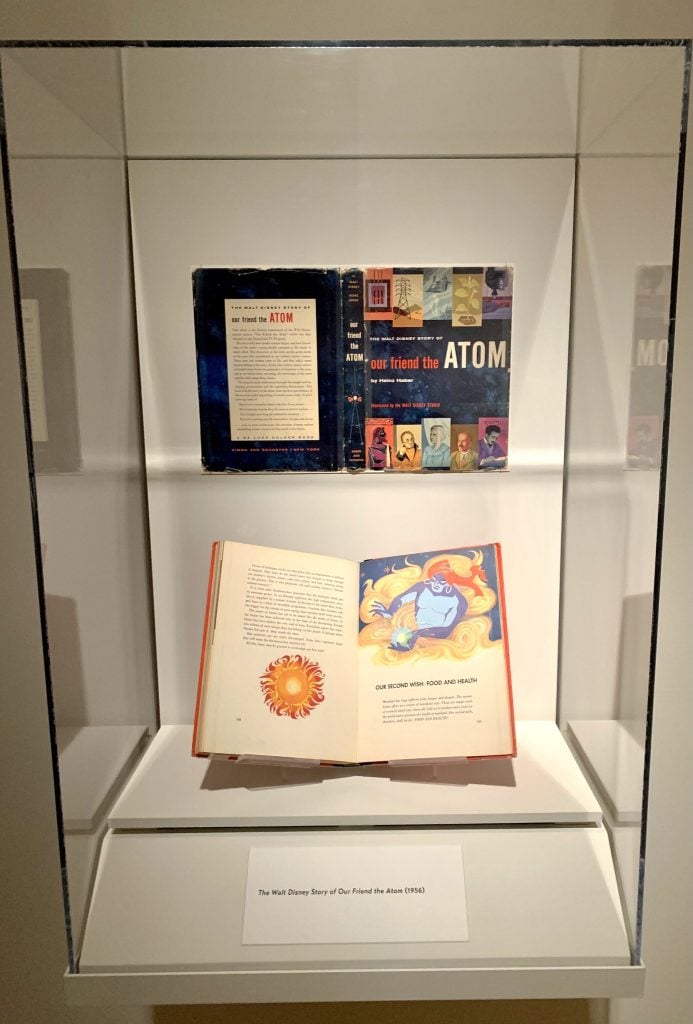
Vitrine featuring artifacts related to Walt Disney’s support of nuclear power, as part of Ken and Julia Yonetani’s installation in the Asia Society Triennial. (Photo by Ben Davis.)

Minouk Lim, It’s a Name I Gave Myself (2015) in the Asia Society Triennial. (Photo by Ben Davis.)
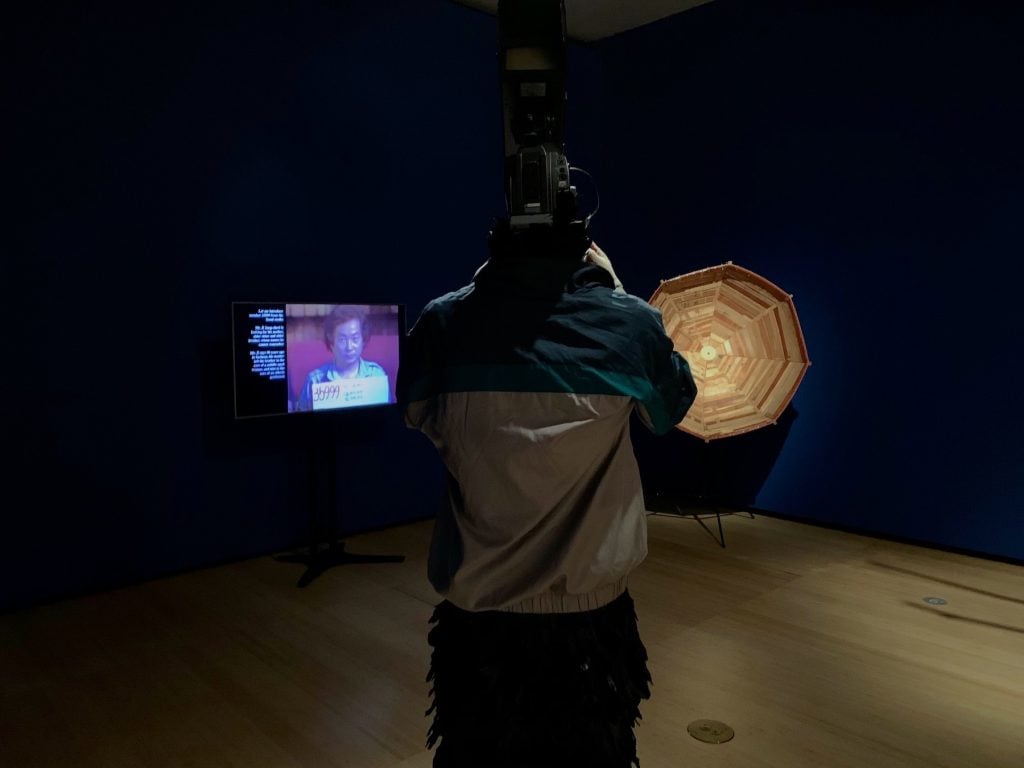
Installation view of works by Minouk Lim in the Asia Society Triennial. (Photo by Ben Davis.)
“Asia Society Triennial, Part 1: We Do Not Dream Alone” is on view at the Asia Society in New York through February 7, 2021.


No comments:
Post a Comment